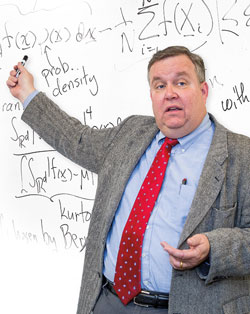Thirty minutes west of Illinois Institute of Technology, at Argonne National Laboratory, lurks a gargantuan machine called “Mira.” The recently inaugurated supercomputer—one of the most powerful on Earth—boasts a peak performance of 10 petaflops, meaning it can execute 10 quadrillion (1016) calculations per second.

Photo: Michael Goss
Yet, according to IIT Department of Applied Mathematics Chair and Professor Fred Hickernell, lightning speed alone is not always sufficient for today’s most demanding applications.
Hickernell works in the area of computational mathematics, often focusing on improving the underlying means by which calculations are performed. These stepwise recipes for solving problems are known as numerical algorithms. Fine-tuning them to improve their efficiency and reliability is critical for complex calculations in many branches of science and engineering.
One critical issue Hickernell has explored is that complex algorithms may fail to provide answers within specified ranges of error. Worse yet, it has often been impossible to predict when a program will perform a given calculation accurately and when it will fail, yielding spurious results.
“The sine function on your calculator can be trusted, because it’s very well understood,” Hickernell notes. “But the next simplest thing is finding the integral of a function, and up until our recent work in the last year, none of those algorithms had real guarantees.”
As Hickernell explains, problems involving many variables can be particularly stubborn to solve with speed and accuracy. In addition to myriad scientific applications, such calculations are critical for the world of financial risk management.
“Although one cannot simultaneously consider the infinite number of possible scenarios, one can get a good approximation of portfolio performance or trading strategy success by generating thousands or millions of possible future scenarios and looking at the distribution of the outcomes,” he says.
Hickernell has devoted much of his mathematical career to this technique, known as Monte Carlo simulation, publishing numerous technical papers on various aspects.
Monte Carlo allows mathematicians to evaluate problems consisting of hundreds or even thousands of variables. The results of Monte Carlo scenarios are pooled and averaged. The process is suggestive of repeated random bets and outcomes in a casino; hence, the technique’s name.
In addition to conventional Monte Carlo simulation, Hickernell has worked with clever refinements of the strategy, including quasi-Monte Carlo, where the random sampling is more evenly spread across the space of possible outcomes, dramatically improving algorithmic efficiency.
“Instead of requiring a million simple random scenarios, one may be able to achieve the same accuracy with only 100,000 or even 10,000 low-discrepancy scenarios,” Hickernell says. In collaboration with Argonne, under a grant from the Department of Energy, Hickernell has been applying quasi-Monte Carlo ideas to the design of computer experiments that will improve nuclear reactor design.
Within the last year, Hickernell returned to the problem of algorithmic failures. In a recent breakthrough, he designed numerical software for Monte Carlo calculations with rigorously guaranteed error bounds, giving users much greater confidence in the validity of their results. He and his collaborators have also introduced these concepts to a wider audience, through the release of the Guaranteed Automatic Integration Library. This software library includes guaranteed algorithms for Monte Carlo calculations and one-dimensional integration.
In the coming era, computers will be capable of exascale computation, performing a blistering 10 quintillion (1018) calculations per second. Hickernell’s efforts to improve algorithmic efficiency and reliability will help ensure such computing power may be used to the best advantage. “A good piece of numerical software is like a well-designed vehicle, capable of transporting the user from a mathematical problem to its solution quickly, comfortably, and reliably,” Hickernell says.
More Online
Guaranteed Automatic Integration Library: https://code.google.com/p/gail
“Monte Carlo Methods—A Little History”: www.youtube.com/watch?v=ioVccVC_Smg